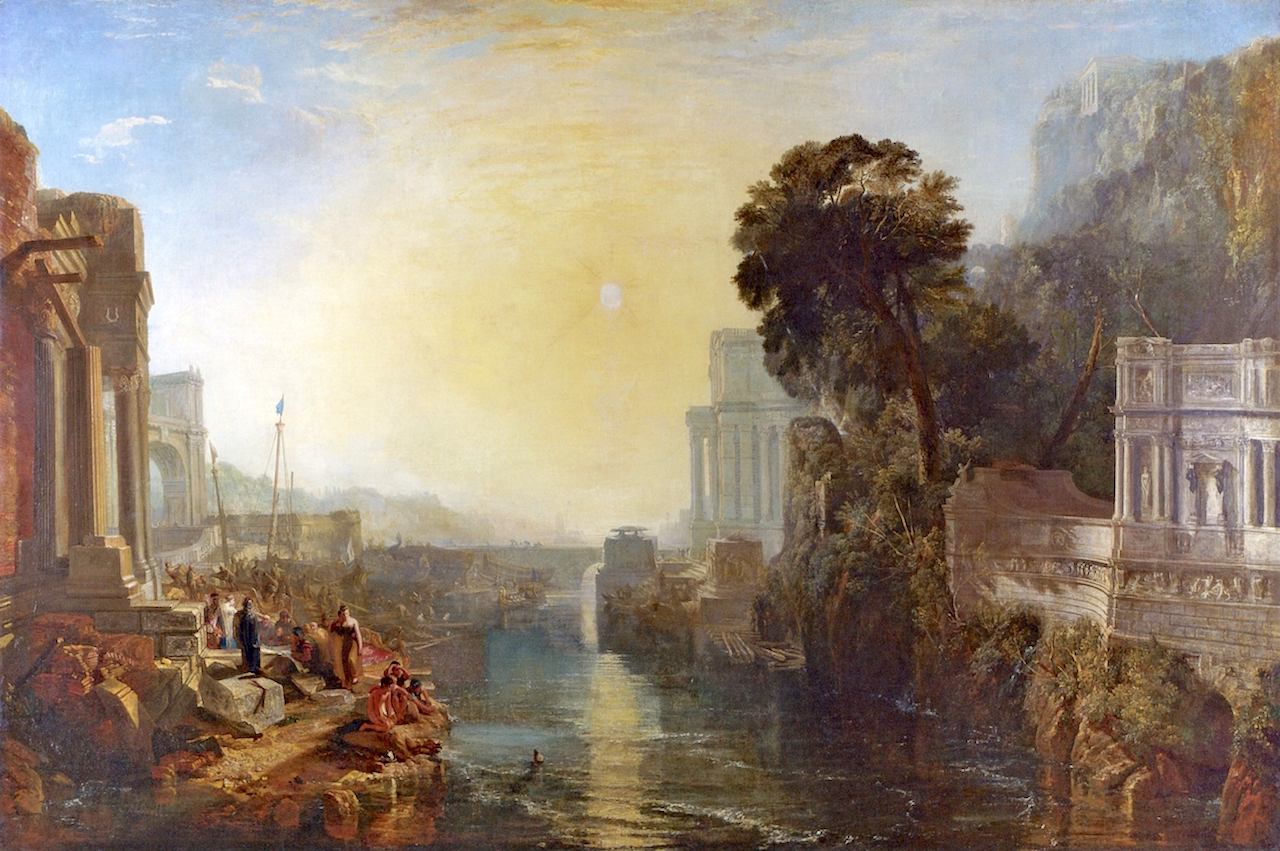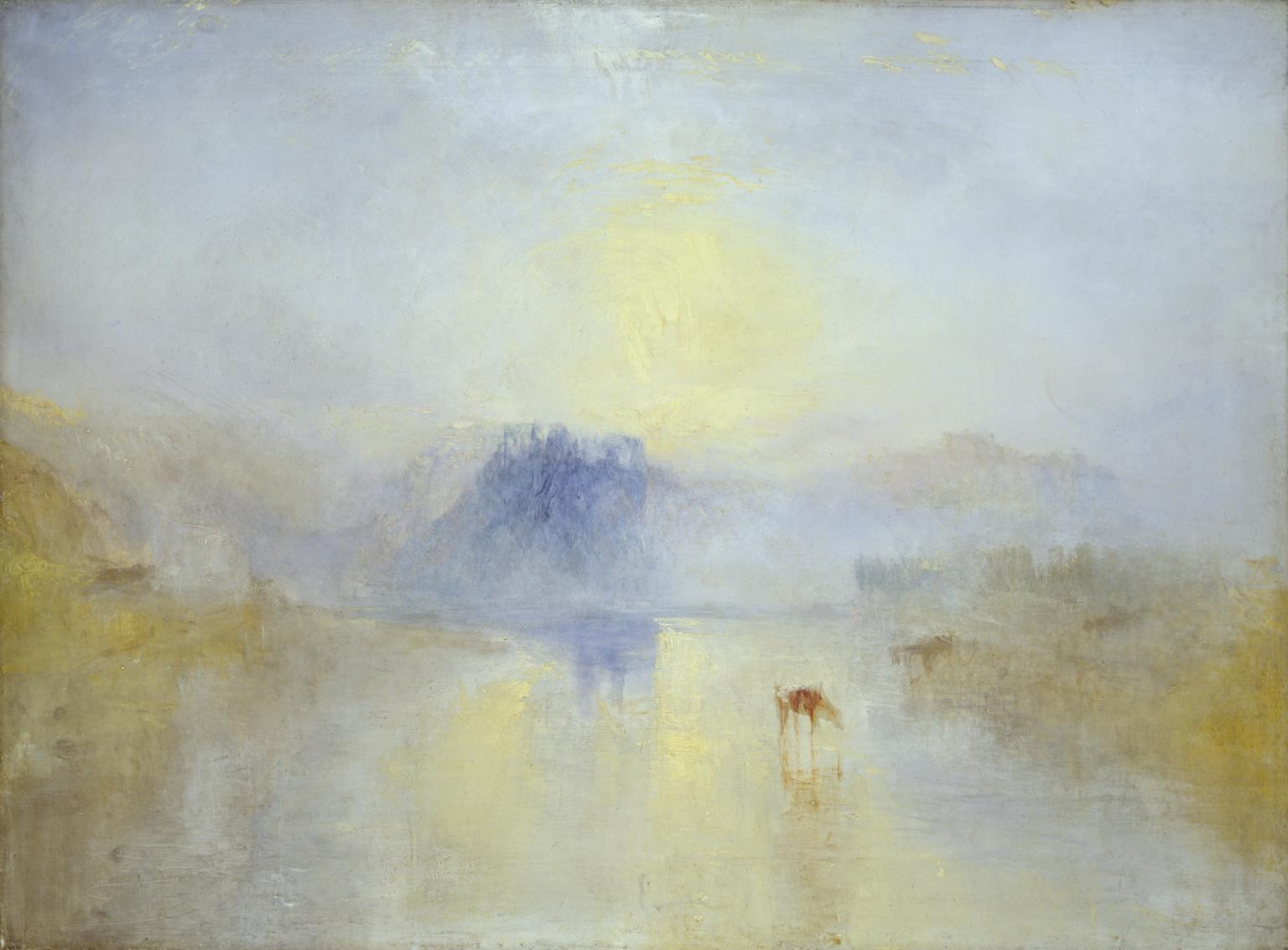 |
J. M. W. Turner, Public domain, via Wikimedia Commons Dort or Dordrecht: The Dort Packet-Boat from Rotterdam Becalmed Yale Center for British Art |
A British Romantic artist whose oeuvre bridges classical landscape traditions and the advent of modern abstraction, Turner's paintings are imbued with an ethereal quality, charged with the sublime power of nature, and suffused with his unique approach to light and atmosphere. Often hailed as the “painter of light,” Turner’s works moved beyond representational fidelity and entered a realm where color, light, and texture transcended physicality and evoked raw emotion.
This essay explores the arc of Turner’s artistic development, the techniques and colors he favored, the recurring themes that defined his artistic pursuits, and presents a critical analysis of seven of his most important paintings. Additionally, the essay examines the modern-day market valuation of Turner’s works, highlighting the enduring fascination and financial appreciation of his art.
I. The Style of J. M. W. Turner
Turner's early artistic training was grounded in the traditions of topographical drawing and the classical landscapes of Claude Lorrain and Richard Wilson. However, as his career progressed, Turner became increasingly experimental. His style evolved from meticulous architectural studies and watercolor landscapes to atmospheric, almost abstract oil paintings that anticipated Impressionism and later modern art.
Turner's mature style is marked by:
-
Dissolution of Form: Turner often blurred the boundaries between land, sea, and sky. His brushwork became looser and more fluid, with subjects emerging and dissolving into luminous atmospheres.
-
Manipulation of Light: Central to his approach was the manipulation of natural light to express mood. He used light not merely as an illustrative tool but as a conceptual force. Often, sunlight, storms, mist, and reflections dominate the canvas more than the physical subjects themselves.
-
Expressive Brushwork: Turner employed a vigorous, experimental brush technique. Swirls, glazes, and scumbles of paint created energy and movement on the canvas, often rendering his compositions more about the sensation of a scene than its literal appearance.
-
Dramatic Composition: Whether depicting sea battles, storms, or pastoral views, Turner composed with drama in mind. His use of diagonals, contrasts between dark and light, and sweeping vistas contributed to the emotional impact of his works.
II. The Colors Turner Used
Turner’s palette evolved throughout his life. In his earlier works, he used relatively restrained earthy tones, aligning with the conventions of 18th-century landscape painting. However, as he matured, his palette became increasingly luminous, featuring brilliant yellows, glowing whites, fiery reds, and marine blues. His signature use of yellow—particularly Naples yellow, chrome yellow, and lemon yellow—played a crucial role in creating the golden hazes and radiant skies characteristic of his later paintings.
Key aspects of Turner’s color usage:
-
Translucent Layering: He built colors in transparent glazes to create depth and glow.
-
Innovative Pigments: Turner was a pioneer in adopting new pigments, some of which (like chrome yellow) were chemically unstable but provided intense hues.
-
Light as Color: His paintings often used color to embody light itself, rather than merely depict it.
-
Vaporous Atmospheres: He used cool blues, grays, and white highlights to suggest mist, spray, and fog, creating an almost tactile atmosphere.
III. Themes in Turner’s Art
Turner’s range of subject matter was vast, but his thematic focus remained consistent in key areas:
-
The Sublime Power of Nature: Nature as an overwhelming, sometimes terrifying force is a recurring theme. Turner dramatized storms, shipwrecks, floods, and natural disasters, placing human figures at the mercy of uncontrollable elements.
-
Historical and Mythological Narratives: He often embedded classical or biblical themes into his landscapes, adding moral or philosophical resonance.
-
Industrial Revolution: Turner was among the first artists to depict the machinery and progress of industrialization. Trains, steamships, and iron bridges appear in his later work as symbols of modernity’s might and menace.
-
Transience and Time: Many of Turner’s late paintings contemplate mortality, impermanence, and decay—manifested through ruinous landscapes, dying light, or dissolving forms.
IV. Critical Analysis of Turner's Paintings
-
“The Fighting Temeraire” (1839)
J. M. W. Turner, Public domain,
via Wikimedia CommonsOil on canvas, National Gallery, London. This painting mourns the passing of Britain’s naval glory. The ghostly ship Temeraire, which had served in the Battle of Trafalgar, is towed by a modern steam tug to be broken up. The painting balances the romantic past (symbolized by the majestic ship bathed in golden light) against the inevitable force of industrial change (the blackened tug and smoky sky). Turner uses luminous yellows and oranges in the sunset to elevate the event to the level of national elegy. The work’s symbolism and technical mastery have made it one of Britain’s most beloved paintings.
J. M. W. Turner, Public domain, via Wikimedia Commons“Rain, Steam and Speed – The Great Western Railway” (1844)Oil on canvas, National Gallery, LondonThis masterful painting merges technological modernity with atmospheric poetry. A train hurtles across a bridge under heavy rain. Turner’s brushwork blurs the boundaries between sky, smoke, and rail—almost dissolving the train into the surrounding elements. The palette is composed of browns, soft blues, and slashes of white and gold. The painting captures a world in transition, full of energy and uncertainty. The hazy rendering of form would later inspire Monet and the Impressionists.Oil on canvas, Tate Britain
“Snow Storm – Steam-Boat off a Harbour’s Mouth” (1842)
J. M. W. Turner, Public domain, via Wikimedia Commons
Turner claimed he had himself lashed to a mast to observe a storm firsthand. The result is this vortex-like composition of a steamboat struggling in a violent sea. The viewer is caught in the maelstrom, with circular brushstrokes evoking the rotation of wind and wave. Dark greens, blacks, and steel grays convey chaos, while flecks of white denote foam and spray. Critics initially ridiculed the painting’s wildness, but it now stands as a precursor to abstract expressionism.
J. M. W. Turner, Public domain, via Wikimedia Commons“The Slave Ship” (1840)Oil on canvas, Museum of Fine Arts, BostonSubtitled Slavers Throwing Overboard the Dead and Dying—Typhoon Coming On, this painting is Turner's condemnation of the slave trade. Human limbs and shackles emerge from blood-red waters, while a monstrous storm swirls above. Turner’s palette here is infernal—burnt orange, crimson, and violet—transforming the sea into a moral abyss. The ship fades into the distance, overwhelmed by nature and guilt. This work remains a harrowing vision of cruelty and divine justice.
J. M. W. Turner, Public domain, via Wikimedia Commons“Dido Building Carthage” (1815)Oil on canvas, National Gallery, LondonTurner revered Claude Lorrain, and this painting is his homage and response. It depicts the legendary Queen Dido overseeing the construction of Carthage. Golden light bathes the city and its classical architecture, creating a sense of harmony and mythic grandeur. Though more structured and linear than his later work, it foreshadows Turner’s obsession with light as subject. Symbolism of rise and fall pervades the painting—imperial ambition and eventual ruin.
kitmasterbloke, CC BY 2.0, via Wikimedia Commons“Ulysses Deriding Polyphemus” (1829)Oil on canvas, National Gallery, LondonThis dramatic mythological painting portrays Ulysses escaping the Cyclops Polyphemus. A fiery dawn illuminates the sea, where Ulysses’ ship recedes into glowing mist. Polyphemus is barely visible in the red clouds above, reinforcing his fading power. The color composition is bold and cinematic, blending myth with natural drama. The storytelling is heightened by Turner’s abstraction of the figures into his atmospheric landscape.
J. M. W. Turner, Public domain, via Wikimedia Commons“Norham Castle, Sunrise” (c.1845) Oil on canvas, Tate Britain - One of Turner’s most poetic and minimal works, this painting shows the medieval Norham Castle almost dissolved in the pink light of dawn. The canvas is suffused with soft rose, lavender, and pale yellow, rendering the structure a mirage more than an object. It is a painting less of architecture than of emotion—an ode to memory and the passage of time. Turner’s near-abstraction here speaks to his belief that painting should evoke rather than describe.
V. Market Value and Sales of Turner’s Paintings
Turner’s paintings, while not always commercially appreciated during his life, are now among the most prized in the world. His works reside in major museums including the Tate Britain, the National Gallery (London), and the Museum of Fine Arts (Boston). Private sales and auctions of his rare works command multi-million dollar prices.
Some significant sales include:
-
“Rome, from Mount Aventine” (1835) – Sold at Sotheby’s in 2014 for £30.3 million (approx. $47.5 million), making it one of the highest prices ever paid for a British painting.
-
“Modern Rome – Campo Vaccino” (1839) – Sold in 2010 for £29.7 million ($44.9 million) to the Getty Museum.
-
Watercolors and sketches – Even Turner’s smaller works, such as watercolors and studies, regularly sell for £500,000 to £2 million depending on provenance and subject.
Most of Turner’s masterpieces are now in public collections, meaning fewer oil paintings come to market. This rarity only increases their value. Collectors prize his unique fusion of Romantic grandeur and proto-modern abstraction, ensuring that his legacy continues to appreciate both artistically and financially.
Conclusion
J. M. W. Turner remains a monumental figure in the history of art—not merely for his technical brilliance, but for his visionary power. His paintings are not just landscapes; they are meditations on time, nature, power, and the sublime. In his hands, color became light, and form dissolved into feeling. Whether depicting myth, history, or industrial progress, Turner’s art always returns to the elemental—to sky, water, sun, and storm.
His influence can be traced in Impressionism, Expressionism, and even Abstract painting. And in a world increasingly shaped by digital reproduction, Turner’s tactile, radiant canvases continue to offer viewers an authentic experience of the infinite, the beautiful, and the transient. As the golden light lingers over a dissolving horizon in one of his canvases, we are reminded of art’s capacity to stir the soul—to see not only with the eyes, but with the heart.
